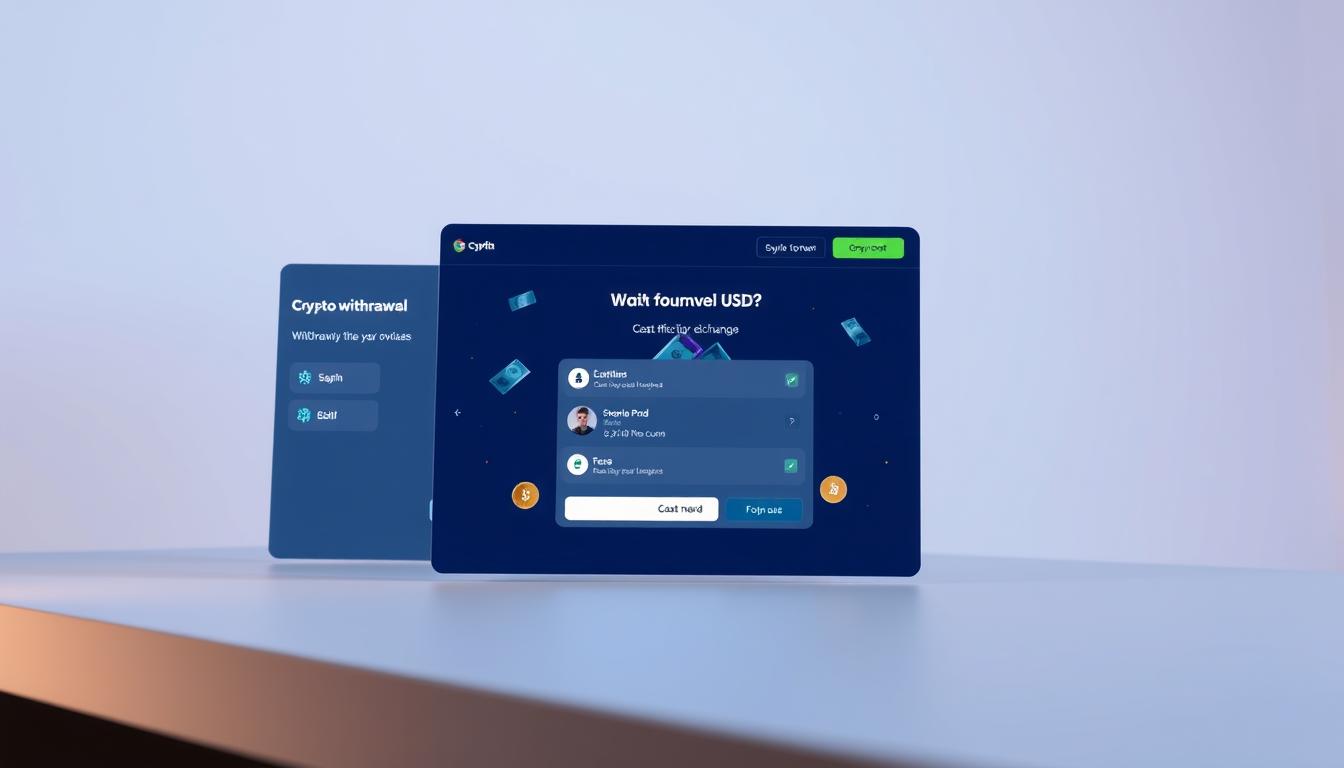Now Reading: Lowest Fees: Cheapest Crypto Exchange to Withdraw USD
- 01
Lowest Fees: Cheapest Crypto Exchange to Withdraw USD
Lowest Fees: Cheapest Crypto Exchange to Withdraw USD

Every dollar counts in the world of digital asset trading. Transaction costs can quickly add up, directly impacting your bottom line. This is especially true when you move your funds from a trading platform to your bank account.
Our guide dives deep into the fee structures of over 20 leading trading platforms. We analyze maker fees, taker fees, and, most importantly, the charges for moving your money out. The goal is simple: to help you keep more of your hard-earned profits.
Whether you trade daily or are a long-term investor, understanding these costs is crucial. Hidden fees can silently erode your returns over time. We provide a clear comparison to empower your financial decisions.
You will also discover proven strategies to reduce expenses. These include using platform-specific tokens for discounts and leveraging volume-based incentives. Choosing the right withdrawal method can also lead to significant savings.
Key Takeaways
- Withdrawal fees are a critical factor that affects your overall trading profitability.
- This analysis covers a wide range of major platforms to identify the best value.
- Understanding the complete fee schedule, including hidden charges, is essential.
- Active traders who frequently move funds benefit most from minimizing costs.
- Strategies like native token discounts and referral programs can lower expenses.
- The guide offers a global perspective, including platforms popular in the US and Australia.
Introduction: Understanding Low Fees in Crypto Trading
Transaction expenses can silently diminish portfolio performance, making fee awareness a critical component of successful trading. High costs directly impact your bottom line, whether you’re actively trading or holding assets long-term. Understanding these structures helps protect your investment gains.
Many participants overlook withdrawal charges when comparing platforms. These seemingly minor costs accumulate rapidly with frequent transactions. A $5-10 fee per transfer can total hundreds of dollars annually for active market participants.
The digital asset industry has become increasingly competitive, with platforms offering various incentives. These include volume-based discounts and token-based fee reductions. Understanding the complete picture—including maker fees, taker fees, and hidden spreads—is essential for accurate profitability calculations.
Minimizing expenses is just as important as making profitable trades. Even successful strategies can be undermined by excessive transaction costs. This foundation prepares you for the detailed platform comparisons that follow.
What Makes a Crypto Exchange Cost-Efficient?
Effective cost management begins with understanding how different trading behaviors affect commission structures. The most financially savvy platforms optimize their fee structure to reward market participation that benefits all users.
When selecting a trading venue, the distinction between liquidity providers and consumers becomes crucial. This fundamental difference shapes how commissions are calculated across various platforms.
Examining Maker and Taker Fee Structures
Maker fees apply when traders place orders that don’t execute immediately. These limit orders add depth to the order book, creating market stability. Platforms typically reward this behavior with lower commission rates.
Conversely, taker fees occur when orders execute instantly against existing liquidity. Market orders or matching limit orders fall into this category. These transactions typically carry higher costs since they consume available market depth.
| Characteristic | Maker | Taker |
|---|---|---|
| Order Type | Limit orders | Market orders |
| Execution Speed | Delayed | Immediate |
| Market Impact | Adds liquidity | Consumes liquidity |
| Typical Fee Range | 0.00% – 0.10% | 0.05% – 0.20% |
| Best For | Patient traders | Quick executions |
Impact on Overall Trading Profits
The difference between maker and taker rates significantly affects long-term profitability. Frequent traders can accumulate substantial savings by strategically using limit orders. Even small percentage differences compound over numerous transactions.
High trading volume amplifies these effects. Active participants should prioritize platforms with competitive maker-taker models. Understanding these dynamics helps when you’re learning how to choose a crypto exchange in the for optimal cost efficiency.
Comparison Overview: Evaluating Top Crypto Exchanges
The competitive landscape of digital trading venues offers diverse pricing models worth careful examination. Our October 2025 review analyzes major platforms using nearly 40 different data points. This thorough approach ensures objective assessment of true cost efficiency.
We evaluated over 20 leading marketplaces across multiple criteria. Trading commissions, withdrawal charges, and supported assets formed the core comparison. Unique platform features and security measures also received careful consideration.
The analysis includes established industry leaders and emerging low-cost alternatives. Each platform demonstrates strengths in specific areas. Some excel with minimal maker-taker fees while others offer complimentary USD transfers.
Geographic accessibility remains a crucial factor in platform selection. The review covers options available to American, Australian, and international traders. Regulatory compliance significantly impacts which services different users can access.
The ideal marketplace depends entirely on individual trading patterns. High-volume participants prioritize competitive commission structures. Occasional traders often benefit more from favorable withdrawal terms and deposit options.
Cheapest Crypto Exchange to Withdraw USD
Platform selection becomes particularly crucial when considering the last-mile costs of transferring profits to your bank account. Different marketplaces offer varying withdrawal fees that can significantly impact your overall returns.
MEXC stands out with its competitive pricing structure. The platform charges zero maker fees and only 0.05% taker fees, making it attractive for active participants.
For American traders, several major exchanges provide free ACH transfers. This eliminates the withdrawal expense entirely when moving funds to US bank accounts.
| Withdrawal Method | Typical Cost | Processing Time | Best For |
|---|---|---|---|
| ACH Transfer (US) | $0 | 1-3 business days | Cost-conscious traders |
| Wire Transfer | $25 | Same day | Urgent transactions |
| Crypto Withdrawal | Network fee only | 10-30 minutes | Digital asset holders |
| PayID/Osko (AUD) | $0 | Instant | Australian users |
Wire transfers typically cost $25 across most platforms. This makes ACH the preferred choice for those who can wait a few days.
Australian users benefit from free AUD transfers through local payment systems. These options provide immediate access to funds without additional charges.
Choosing the right method based on your needs can lead to substantial annual savings. Frequent transfers amplify these cost differences significantly.
Analyzing Withdrawal Fees Across Leading Platforms
The true cost of moving your digital assets becomes apparent when examining withdrawal fee structures across different marketplaces. Significant variations exist that can dramatically impact your net returns.
Frequent traders who move funds often feel this effect the most. A seemingly small charge per transaction adds up quickly over a year.
Australian marketplaces like Swyftx, Independent Reserve, and CoinSpot offer a major advantage. They provide free AUD fiat withdrawals, charging only the necessary blockchain network fee for moving coins.
Independent Reserve charges set amounts: 0.0002 BTC for Bitcoin and 0.005 ETH for Ethereum. This predictability helps with financial planning.
CoinSpot is attractive for stablecoin users, with a low USDT withdrawal fee of just 3 USDT. This is lower than many competitors.
| Platform | BTC Withdrawal | ETH Withdrawal | USDT Withdrawal | Fiat Withdrawal |
|---|---|---|---|---|
| Swyftx | Network fee only | Network fee only | Network fee only | AUD Free |
| Independent Reserve | 0.0002 BTC | 0.005 ETH | 10 USDT | AUD Free |
| CoinSpot | 0.0003 BTC | 0.005 ETH | 3 USDT | AUD Free |
| Gate.io | ~AUD $1.65 | ~AUD $0.75 | ~AUD $0.75 | Limited |
| Coinbase | Network-based | Network-based | Network-based | ACH Free / Wire $25 |
For American users, major platforms like Coinbase, Kraken, and Gemini offer free ACH transfers for USD. Wire transfers typically cost around $25, making ACH the better choice for savings.
It is crucial to understand that network-based fees are not static. They fluctuate with blockchain congestion. A Bitcoin withdrawal could cost $5 or over $30 depending on network traffic.
Timing your transfers during low-traffic periods can lead to substantial savings. Some platforms, like OKX and KuCoin, have variable structures that change often.
Always check the current rates before initiating a transfer. Understanding both the platform charge and the network fee is essential for calculating your true cost per transaction.
Comparing Trading Fee Structures: Spot vs. Futures
The distinction between spot trading and futures contracts extends beyond strategy to cost structures. Different fee models apply to these market types, affecting your overall expenses significantly.

Futures markets typically offer lower percentage fees than spot trading. This reflects the higher leverage and trading volumes in derivatives markets. Understanding these differences helps optimize your cost management.
Spot Trading Fee Breakdown
Spot market fees show considerable variation across platforms. MEXC stands out with 0% maker fees and 0.05% taker fees for immediate executions.
Pionex uses a simple flat 0.05% rate for both roles. Major platforms like Binance and KuCoin typically charge 0.10% for standard spot transactions.
Futures Trading Fee Differences
Derivatives trading features consistently lower commission structures. Bybit leads with just 0.01% for makers and 0.06% for takers on futures contracts.
Most platforms cluster around 0.02% maker and 0.04-0.06% taker fees for futures. Strategic allocation between markets can reduce costs by 30-50% for active participants.
Volume-based discounts further complicate comparisons. High-volume traders can access significantly reduced rates across both spot and futures markets.
Exploring Tiered Volume Discounts and VIP Benefits
Active market participants can unlock significant savings through tiered volume discount programs offered by leading platforms. These systems progressively lower your fees as your 30-day trading volume increases.
This creates a substantial cost advantage for high-frequency traders and institutions. The discounts can be dramatic.
For example, Binance’s VIP system can reduce rates to 0.009% for makers and 0.018% for takers at the highest tiers. This represents a massive discount from standard rates.
Other exchanges offer even more aggressive incentives. KuCoin’s tiers can achieve negative maker rebates, effectively paying users to provide liquidity.
Bybit’s VIP program offers some of the lowest institutional rates. Top-tier traders can access maker fee of 0.005%.
| Platform | High-Volume Maker Fee | High-Volume Taker Fee | Key Requirement |
|---|---|---|---|
| Binance VIP | 0.009% | 0.018% | >$150M monthly volume |
| KuCoin | Negative Rebate | 0.025% | Very high 30-day volume |
| Bybit VIP | 0.005% | 0.015% | Qualified institutional level |
| Crypto.com | 0% (with staking) | Varies | Volume tier + CRO stake |
Most platforms calculate these tiers based on a rolling 30-day volume. Your discount level adjusts automatically each month.
VIP benefits often extend beyond just lower fees. They can include priority support, higher withdrawal limits, and dedicated account managers.
Consolidating your trading activity on a single platform can help you reach these beneficial tiers faster. The savings for active users are well worth the strategic effort.
Leveraging Native Tokens to Lower Trading Costs
Many trading platforms offer a powerful tool for reducing costs: their own native digital tokens. Holding these assets can provide direct discounts on transaction fees. This creates immediate value for active users.

These tokens function as loyalty rewards within their respective ecosystems. The discounts vary by platform and the amount you hold.
Discount Benefits with BNB, OKB, and KCS
Major exchanges provide significant incentives. Using Binance’s BNB for fee payment grants up to a 25% reduction. OKX users holding OKB can see fee discounts scaling to 40%.
KuCoin’s KCS token commonly offers a 20% discount. This can reach 60% for large holders combined with volume tiers.
Other platforms have similar models:
- MEXC’s MX token gives a 20% discount, jumping to 50% for holders of 500+ MX.
- Bitget’s BGB typically provides a 20% fee reduction.
- Staking Crypto.com’s CRO can lead to zero maker fees at higher tiers.
The strategic value extends beyond just lower fees. It includes staking rewards and potential token appreciation. Calculating the return based on your trading volume is key to maximizing this benefit.
Identifying and Minimizing Hidden Costs
Beyond the visible commission structures lie hidden expenses that can significantly impact your overall profitability. Many participants overlook these subtle charges when calculating their true transaction cost.
The bid-ask spread represents one of the most significant invisible fees. This gap between buying and selling prices functions as an implicit charge on every market order. Wide spreads can cost more than the stated trading percentage.
| Hidden Cost Type | Typical Range | Impact on $1,000 Trade | Minimization Strategy |
|---|---|---|---|
| Bid-Ask Spread | 0.1% – 2.0% | $1 – $20 | Use limit orders |
| Inactivity Fees | $2 – $5 monthly | Varies by balance | Maintain account activity |
| Network Fees | $1 – $50+ | Fixed per transaction | Choose low-fee networks |
| Currency Conversion | 0.5% – 1.5% | $5 – $15 | Use base currency |
Some platforms advertise zero-fee trading but compensate with wider spreads. A 1% spread on a $1,000 trade equals a $10 hidden fee. Inactivity charges represent another concern for occasional users.
Additional hidden costs include network fees during blockchain congestion and currency conversion charges. Bank transfers typically offer the lowest deposit expenses compared to card payments.
To minimize these expenses, choose platforms with tight spreads and high liquidity. Use limit orders instead of market orders for better control over execution prices.
Unique Features That Enhance Exchange Value
Modern trading platforms differentiate themselves through specialized tools that go beyond basic buying and selling. These unique features can provide significant value, sometimes justifying a slightly higher fee for traders who utilize them fully.

Advanced Trading Tools and Automation
Automation is a major advantage. Pionex offers built-in trading bots at no extra cost. These include grid and DCA bots that automate complex strategies.
OKX provides advanced DeFi integration within its platform. This allows seamless movement between centralized and decentralized finance.
For beginners, exchanges like Bitget popularized copy trading. This feature lets users automatically replicate successful strategies.
Bybit excels for professional derivatives trading. It offers advanced order types and low-latency execution for futures.
Staking options on these platforms provide passive income. Users can earn on dozens of assets without transferring funds.
| Platform | Specialized Feature | Primary User Benefit |
|---|---|---|
| Pionex | Built-in Trading Bots | Automation at no extra cost |
| OKX | DeFi Integration | Seamless protocol access |
| Binance | Extensive Ecosystem | All-in-one crypto hub |
| Crypto.com | Visa Card Integration | Spend crypto for cashback |
| Various | In-Platform Staking | Passive income generation |
The right set of tools depends entirely on your strategy. Automation benefits active users, while copy trading helps newcomers. Evaluating these features is key to maximizing your platform’s value.
Security, Safety, and Regulatory Compliance
Regulatory compliance and robust security measures form the foundation of trustworthy digital asset exchanges. No amount of fee savings can compensate for losing assets to security breaches or platform insolvency.
Before opening an account, research the platform’s security history thoroughly. Look into past incidents, how the company responded, and whether users received compensation. Understanding their track record reveals their commitment to protecting assets.
Essential security features should include mandatory two-factor authentication and withdrawal address whitelisting. Email confirmations for transfers and device authorization add crucial protection layers. These measures help prevent unauthorized access to user accounts.
Some platforms offer additional safeguards like Binance’s SAFU insurance fund. This mechanism allocates trading fees to protect users during security incidents. Proof-of-reserves audits verify that exchanges hold sufficient assets to cover all user balances.
Regulatory compliance varies significantly across jurisdictions. US-licensed platforms operate under strict oversight that provides consumer protections. However, these regulations may limit available features compared to international options.
Always verify service availability in your region before creating an account. Some platforms face restrictions due to regulatory uncertainty. Leading exchanges store 90-95% of assets in cold storage, keeping them safe from online threats.
The balance between security and feature availability is crucial. Heavily regulated platforms may offer fewer coins but provide institutional-grade protection standards. This trade-off ensures your investments remain secure.
Integrating Fiat-to-Crypto and Crypto-to-Crypto Fee Strategies
The pathway from national currencies to blockchain-based assets involves distinct fee structures that traders must master. Smart investors understand that different transaction types carry varying cost implications.
Understanding On-Ramp and Off-Ramp Costs
On-ramp expenses represent the total cost of converting traditional money into digital assets. These fees combine platform charges with payment processor costs.
Bank transfers typically offer the lowest deposit fees at 0-1%. Debit cards cost 1-2.5%, while credit cards often charge 2.5-4% due to higher risk.

| Deposit Method | Typical Fee | Processing Time | Best For |
|---|---|---|---|
| Bank Transfer (ACH) | 0-1% | 1-3 business days | Cost-conscious users |
| Debit Card | 1-2.5% | Instant | Quick access |
| Credit Card | 2.5-4% | Instant | Emergency funding |
| Wire Transfer | Flat $10-25 | Same day | Large amounts |
Platform conversion fees range from 0.5% to 1.5% across different marketplaces. Spreads can add another 0.5-1% to the total expense.
Crypto-to-crypto trading typically involves lower fees than fiat conversions. This makes it economical to deposit traditional currency once, then conduct subsequent trading in digital asset pairs.
Network fees apply when moving blockchain assets between wallets or exchanges. These costs fluctuate based on congestion and can range from $1 to $50 per transaction.
Strategic fee minimization involves using bank transfers for deposits despite slower processing. Conducting most trading in cryptocurrency pairs reduces repeated conversion expenses.
Maximizing Savings with Referral Codes and Loyalty Programs
Beyond trading volume and token holdings lies another powerful discount mechanism: referral networks. These programs provide immediate fee reductions without requiring large investments or high activity levels.
New account holders can typically secure 10-40% rebates on trading fees through referral codes. This represents the easiest entry point for cost reduction. Platforms like KuCoin offer up to 40% fee sharing between both parties.
MEXC’s system combines referral commissions with token-based benefits. Users can earn 40% on referred trading fees plus 10-50% additional rebates with MX token holdings. This creates compounded savings.
Binance achieves up to 20% total discount when stacking referral benefits with BNB fee payments. Bybit provides permanent 20% spot fee rebates plus futures bonuses through their program.
Loyalty benefits extend beyond initial signup bonuses. Active users gain access to trading competitions, birthday rewards, and promotional fee reductions. These ongoing perks add significant value.
Strategic use of referral codes requires no downside. They provide immediate benefits without increasing costs or creating obligations. Combining referral discounts with volume tiers and token benefits can reduce effective fees by 50-70%.
Practical Tips for Optimizing USD Withdrawals
Strategic timing transforms routine transactions into cost-saving opportunities. Even fixed percentage fees can spike during high volatility due to slippage. Trading during low-volume hours maintains efficiency while reducing hidden expenses.
Network costs for blockchain transactions vary significantly. Ethereum gas fees can reach $20-50 during congestion. Alternatives like Polygon or Arbitrum offer sub-$1 transfers for substantial savings.
Consolidate multiple small withdrawal requests into fewer large transactions. This approach minimizes the impact of fixed fee structures. You achieve better per-dollar economics through scale.
| Withdrawal Method | Typical Cost | Processing Time | Best Use Case |
|---|---|---|---|
| ACH Transfer | $0 | 1-3 business days | Regular cashouts without urgency |
| Wire Transfer | $10-40 | Same day | Emergency fund access |
| Stablecoin Conversion | Network fee only | 10-30 minutes | International users |
| Internal Platform Transfer | $0 | Instant | Moving funds between accounts |
Convert altcoins to stablecoins before cashing out if timing permits. USDT or USDC network fees are often lower and more predictable. Choose optimal blockchain networks like TRC-20 ($1-2) over ERC-20 ($10-30).
Verify minimum withdrawal amounts before initiating transactions. Some platforms require $10-100 minimums that could trap small balances. Planning around actual cash needs prevents premature conversion expenses.
Consider leaving working capital on the platform between trading sessions. This reduces cumulative transfer costs while maintaining flexibility. Balance this approach against security considerations for your specific situation.
Real-World Case Studies: Trader Experiences and Savings
Documented experiences from active market participants show how cumulative savings from fee optimization can reach thousands annually. These real-world examples demonstrate practical strategies that work for different types of traders.
One active day trader discovered that a 0.10% fee difference on $100,000 monthly volume equaled $100 in additional costs each month. By switching platforms, this trader achieved a 72% reduction in trading expenses.
A crypto investor making weekly bank transfers was paying $25 per transaction before discovering free alternatives. This simple change eliminated $1,300 in annual costs with minimal adjustment to their routine.
Another trader moving digital assets between exchanges frequently faced high network fees. By selecting optimal transfer methods and timing, they reduced costs from $30 to under $0.50 per transaction.
These examples prove that strategic platform selection and payment method choices create substantial savings. Even small adjustments compound significantly over time for regular traders.
The key insight is that fee optimization doesn’t require changing trading strategies. Smart decisions about where and how to conduct trades preserve profits without adding market risk.
Conclusion
Optimizing your investment returns involves more than just successful trades—it requires strategic platform selection. The cryptocurrency industry offers diverse options for every type of participant.
Marketplaces like MEXC and Pionex lead with minimal trading fees, while established exchanges balance competitive costs with advanced tools. Beginners often prefer user-friendly platforms despite slightly higher base rates.
Your personal trading frequency, location, and feature needs determine the ideal choice. High-volume traders benefit most from volume tiers and token discounts.
Understanding the complete fee structure empowers informed decisions. The right selection protects your digital assets while maximizing net profitability.
FAQ
What is the difference between maker and taker fees?
Maker fees are charged when you add liquidity to the order book by placing an order that isn’t immediately filled. Taker fees apply when you remove liquidity by filling an existing order. Platforms often reward makers with lower fees to encourage market depth.
How can I reduce my trading costs on an exchange?
You can lower your trading costs by increasing your 30-day trading volume to qualify for tiered discounts, holding and paying fees with the platform’s native token like BNB or OKB, and using limit orders to benefit from lower maker fees.
Are there hidden costs I should watch for when withdrawing USD?
Yes, beyond the stated withdrawal fee, watch for network charges, currency conversion spreads if your account balance isn’t in USD, and potential intermediary bank fees. Always review the platform’s full fee schedule.
What features should I look for in a cost-efficient platform?
Look for transparent fee structures, high liquidity for better trade execution, tiered volume discounts, and benefits for using a native token. Strong security measures are also crucial to protect your digital assets.
How do deposit methods like a debit card affect overall costs?
Depositing with a credit or debit card is often fast but typically incurs higher processing fees compared to bank transfers or ACH. These on-ramp costs can add up, especially for frequent traders.
Why is security important when choosing a low-fee exchange?
While low fees save money, robust security protects your funds. A secure platform uses measures like two-factor authentication and cold storage for assets. Balancing low costs with strong safety is key for long-term success.
Can staking or loyalty programs help reduce fees?
Absolutely. Many platforms offer reduced trading fees if you stake their native token. Loyalty and referral programs can also provide credits or discounts that lower the overall cost of your trades and withdrawals.












